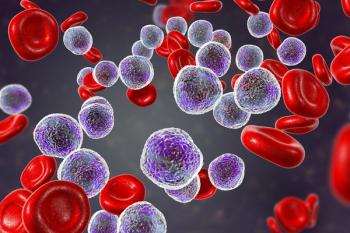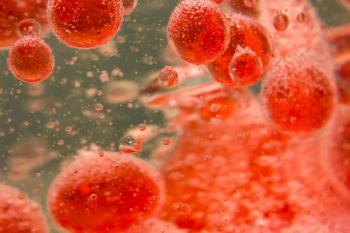
- ONCOLOGY Vol 16 No 3
- Volume 16
- Issue 3
Phase II Study of Rituximab in Combination With Fludarabine in Patients With Chronic Lymphocytic Leukemia
This phase II trial investigated the safety and efficacy of a combined-modality treatment with rituximab (Rituxan) and fludarabine (Fludara) in patients with fludarabine- and anthracycline-naive chronic lymphocytic lymphoma (CLL).
This phase II trial investigated the safety and efficacy of a combined-modality treatment with rituximab (Rituxan) and fludarabine (Fludara) in patients with fludarabine- and anthracycline-naive chronic lymphocytic lymphoma (CLL). The rationale for combining rituximab and fludarabine includes the single-agent efficacy of both drugs, the possible synergism of rituximab and chemotherapy, and no apparent overlapping toxicities.
A total of 32 patients were treated with fludarabine administered at a standard dose of 25 mg/m²/d (days 1-5, 29-33, 57-61, 85-89). The first two infusions of rituximab were given together with fludarabine on days 57 and 85, while the following doses (375 mg/m²) were given on days 113 and 151. Baseline characteristics of 30 eligible patients (19 previously untreated, 11 relapsed) were as follows: median age, 59 years (range: 30-70 years); males, 21 patients (70%); Binet stage B, 21 patients (70%), Binet stage C, 9 (30%); median number of prior regimens in previously treated patients, 1 (range: 1-3).
Side effects consisting of fever, chills, and exanthema of the skin were mild. Fever and chills were mainly related to the first rituximab infusion. Toxicity was World Health Organization grade 1/2 in 47% of patients and grade 3/4 in 3%. Hematologic toxicity included neutropenia (grade 1/2 in 30%, grade 3/4 in 37%) and thrombocytopenia (grade 1/2 in 20%, grade 3/4 in 10%). One patient died after the second cycle of fludarabine, during prolonged thrombocytopenia due to cerebral bleeding. No hemolytic anemia has been noted. There was a total of 29 infections in 15 patients (sinusitis/rhinitis/tonsillitis in 5 patients, herpes labialis/zoster infection in 5 patients, and fever of unknown origin in 4 patients). None of these infections was fatal.
The overall response rate (complete plus partial response) was 90% (26/29 evaluable patients). In previously untreated patients, 16 of 18 responded (89%). Out of 29 patients, 10 achieved a complete response: 5/18 were untreated, 5/11 pretreated; 9/21 Binet stage B, 1/8 Binet stage C. There were 1/29 patients with no change and 2/29 patients with progressive disease. The median time to progression has not been reached after a median follow-up of 10 months.
CONCLUSION: The combination regimen of rituximab and fludarabine is very effective and feasible in this group of patients.
Articles in this issue
almost 24 years ago
Single-Agent Rituximab in Early-Stage Chronic Lymphocytic Leukemiaalmost 24 years ago
Recruitment for Trial of Adjuvant Trastuzumab Under Wayalmost 24 years ago
Rituximab in the Treatment of Acquired Factor VIII Inhibitorsalmost 24 years ago
Support for New Medicare Pay Formulaalmost 24 years ago
Irinotecan-Containing Regimen Improves Survival in Small-Cell Lung CancerNewsletter
Stay up to date on recent advances in the multidisciplinary approach to cancer.


















































































